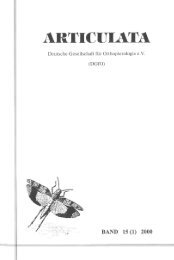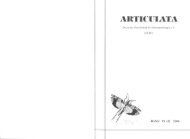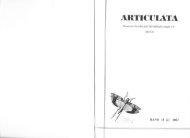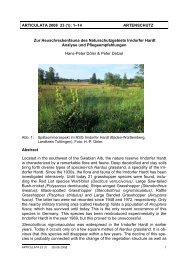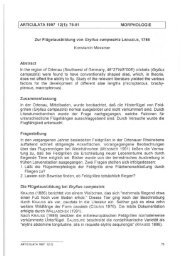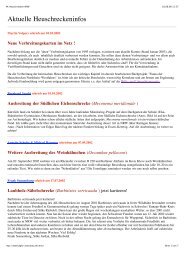Willemse, F.
Willemse, F.
Willemse, F.
Create successful ePaper yourself
Turn your PDF publications into a flip-book with our unique Google optimized e-Paper software.
would accompany the family into the mountains, sometimes on horseback. The<br />
family still treasures many dear memories of these holidays.<br />
At the end of a collection day, the catch of the day had to be prepared and labelled.<br />
This meant that specimens belonging to the Ensifera had to be dissected,<br />
their stomach and intestines removed. Subsequently, the body shape was restored<br />
with cotton wool. As catches more often than not numbered in the hundreds<br />
rather than the tens, the whole family participated. Upon return to The Netherlands,<br />
the specimens were mounted and labelled, boxes constructed, and specimens<br />
identified. All in all this would normally take about 3 months. This is quite a<br />
short period, considering the amount of specimens brought back (2.500–6.000<br />
per trip), the fact that labels were still printed by hand, and that the wooden boxes<br />
were made by Fer himself (every year 30-50 boxes). As with the collecting,<br />
Fer was assisted in many ways by family members.<br />
Even in the relatively short span of Fer's life, fieldwork changed with the introduction<br />
of various kinds of equipment like the bat detector (useful for locating species<br />
producing a very soft or high-pitched calling song), a GPS device (rendering<br />
coordinates), and of course sound recording equipment. At first, he was<br />
somewhat sceptical about bioacoustics as a means to be used in taxon recognition.<br />
As described by himself in the acknowledgements of his last paper on Chorthippus,<br />
his views later changed:<br />
"When I first met Otto von Helversen in 1986, he assured me that based on song<br />
recording there was no doubt in his mind that C. vagans did occur in Greece<br />
whereas based on the morphology alone it was not at all that obvious to me. As a<br />
boy I found Chorthippus apricarius new to the Dutch fauna, based on its song<br />
quite distinct from its morphologically syntopic look-alikes (C. <strong>Willemse</strong> 1940). It<br />
was obvious that song characteristics, particularly among this group of grasshoppers,<br />
constitute an easy and reliable means to establish the identity of certain<br />
individuals or populations." (Zool. Meded. 83)<br />
The first sound recordings were made was in 1986, and the last in 2004. Fer<br />
recorded the songs of some 130 species, all of which have been handed over to<br />
Baudewijn Odé.<br />
Collection<br />
The collection and library of his father C. <strong>Willemse</strong> were bequeathed, upon his<br />
death in 1962, to the Natural History Museum in Maastricht. This museum focuses<br />
on regional fauna, flora, and paleontology. It may seem odd to donate a collection<br />
focused on South East Asian Orthoptera to a regional museum rather<br />
than a larger national museum in Amsterdam or Leiden. However, C. <strong>Willemse</strong><br />
had very strong ties with the Museum in Maastricht and the "Natuurhistorisch<br />
Genootschap in Limburg", which he chaired for 8 years. Before his father's collection<br />
was moved to Maastricht, Fer <strong>Willemse</strong> made a small reference collection<br />
of the European material, collected by himself, and some South East Asian taxa,<br />
which were still unidentified or pending further studies.<br />
The reference collection rapidly expanded to a significant collection that also included<br />
type material. A separate paper will discuss the type material. The collection<br />
was expanded in four ways.<br />
110 [31.05.2010] ARTICULATA 25 (1)



